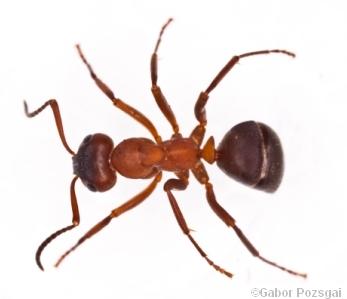Formica sanguinea (Slave-maker ant)
Status
European: Not threatened.
UK: Nationally Scarce / Notable (but likely to be under-recorded).
Description
The size of this ant, colouration, notched clypeus and nesting habit make it easily distinguishable from the wood ants. A large aggressive ant with workers up to 10mm long, F. sanguinea, is commonly referred to as the blood-red or slave-maker ant because of the bright red coloration of the head, legs and thorax. The abdomen is entirely black.
A facultative social parasite, Formica sanguinea is well documented for its “slave raids” on black ants such as Formica fusca and Formica lemani, hence its common name. The slave-making ant uses parasitism to found new nests and also to boost the number of workers in the nest. New queens and males are produced sporadically in July and August. There is no nuptial flight with mating taking place in close proximity to the natal nest.
UK Distribution
In the UK Formica sanguinea has a disjunct distribution. In Scotland it occurs in the central Highlands and Moray / Aberdeenshire while in England it is mainly found in the south east but also in scattered localities on the Welsh border.
Habitat and Foraging
In the Highlands the ant is associated with native pine forests and plantation forest, including non-native plantations such as sitka spruce and larch.
Unlike the wood ants, the slave-making ant does not create thatched mounds but instead nests in deadwood such as tree stumps and logs or under stones. Sometimes a small thatch can be present were woody material has been excavated, but this is not on the scale of the wood ant thatch. F. sanguinea is the most thermophilic of our UK ants and nests are often on south-facing slopes or in woodland open to the south.
Workers usually forage singly, although they may recruit nestmates to a particularly fruitful food resource. This species is predatory on other ants but will also take seeds, berries and honeydew from aphids.
Raiding behaviour
One of the most fascinating aspects of F. sanguinea behaviour is the enslavement of related ants of the genus Formica. Larvae and pupae of the captured ants are taken back to the nest of F. sanguinea where they mature/eclose and behave as if they are F. sanguinea individuals. Slaves carry out various kinds of tasks in the nest including foraging, brood rearing, nest maintenance and even assisting with slave raids themselves.
Sequence of events during a raid:
- Scouts of Formica sanguinea leave the nest to search for suitable host nest; when the scout finds a suitable nest, it hurries directly back to the mother nest to alert other individuals in the nest.
- After a few minutes the slave-makers organise themselves into “platoons” of 100 or so raiders which leave the mother nest and head towards the target colony.
- Eventually a column of slave-makers joining the mother nest and target nest is formed. This column can be more than 12m long, 50cm wide and include over 1000 raiders! (Mori et al, 2000).
- When the raiders reach the target colony they start to dig out the entrance to the nest to allow an easier entrance en masse.
- Intense fighting between the slave-makers and the resident ants occurs and there are many losses of individuals on both sides. Injured or dead ants from the target colony are carried back to the slave-maker nest. Fighting takes place deep inside the nest but some resident ants manage to escape with brood.
- The slave-makers move deep into the target nest to capture pupae (both worker and reproductive), larvae and adult workers which are taken back to the slave-maker’s nest.

